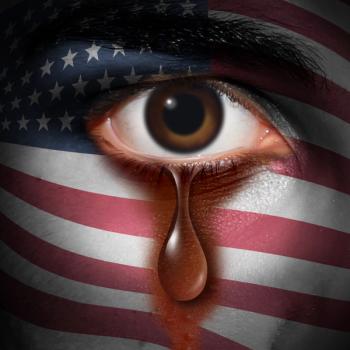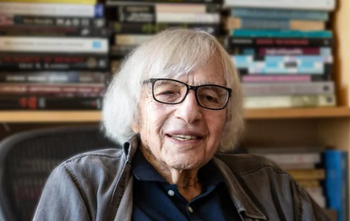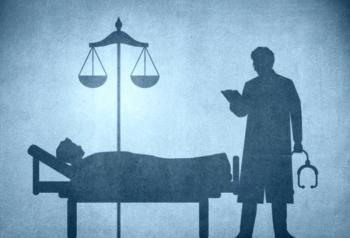
- Vol 40, Issue 4
Changing the Narrative: Mental Illness and Gun Violence
Public responses to mass shootings, in particular, often include speculations about the shooter’s mental state. But what is the real connection between gun violence and mental illness?
Another day, another shooting, another finger pointing to mental illness.
With the extensive news coverage of gun violence, it seems there is a mass shooting in the United States every single day—but the reality is far worse.
According to the Gun Violence Archive, there were 44,313 gun violence deaths in the United States in 2022. Of these, 20,223 deaths were from homicide, murder, accidents, or defensive gun use and 24,090 were from suicide. Furthermore, 647 qualified as mass shootings,1 which are broadly defined as incidents in which 4 or more individuals—not including the shooter—are shot.2 Alarmingly, gun violence is now the leading cause of death for US children and adolescents.3
So far, 2023 is looking similarly violent. As of late March, there were 10,007 gun violence deaths and 130 mass shootings in 2023. Of the deaths, 4265 were from homicide, murder, accidents, or defensive gun use, and 5742 were from suicide.4
Public responses to mass shootings, in particular, often include speculations about the
This belief is reportedly common among the general US population regardless of political affiliation. According to a CBS News poll from June 2022, 47% of respondents believe mass shootings are more common in the United States than in other countries because of mental health issues, and 60% and 61% of Republicans and Democrats, respectively, believe better mental health screening and treatment would be 1 of the most effective ways to prevent mass shootings.6
As psychiatric clinicians know, the
The Real Role of Mental Illness
It is estimated that about 1 in 5 mass shooters has a serious mental illness (SMI) at the time of the shooting,7 and around 3% of overall gun violence can be attributed to SMI.8 According to the Association of American Medical Colleges, nearly 6% of US adults, or 14 million individuals, had an SMI such as bipolar disorder, schizophrenia, or major depressive disorder in 2020—and yet, if all SMIs were to disappear, more than 90% of all violent incidents, including those involving guns, would still occur and overall violence would decrease by only about 4%.9
“Research shows that only about 20% of mass shooters have a major mental illness,” Alan D. Blotcky, PhD, told Psychiatric Times®. “So mental illness does not account for our country’s daily problem with mass shootings.” Blotcky is a clinical and forensic psychologist in private practice in Birmingham, Alabama.
It has also been reported that individuals with SMI are over 30% more likely to be victims of gun violence than they are to be perpetrators.10 This includes suicide, which makes up three-fifths of all gun violence deaths; is the 10th leading cause of death among all US individuals; and is the second leading cause of death among individuals aged 25 to 34 years. It is estimated that 46% of individuals who commit suicide have a known mental health condition.11
“Most gun violence is self-directed. Suicide accounts for more than half of US gun fatalities and mental illness is strongly associated with increased risk of suicide,” added Ronald W. Pies, MD, who is professor emeritus of psychiatry and lecturer on bioethics and humanities at SUNY Upstate Medical University, a clinical professor of psychiatry at Tufts University School of Medicine, and previous editor-in-chief of Psychiatric Times.
“Our patients with SPMI, serious persistent mental illness, are at higher risk for being victimized for gun violence,” said Rahn Kennedy Bailey, MD, who is chairman of psychiatry at LSU Health Sciences Center-New Orleans. According to Bailey, the reason for this is 4-fold (
Many mental health organizations, including the American Psychiatric Association (APA), the American Academy of Child and Adolescent Psychiatry (AACAP), and the National Alliance on Mental Illness (NAMI) have also stated that overestimating the prevalence of SMI in mass shooters may have serious negative effects. In June 2022, APA, AACAP, and NAMI released a joint statement with a total of 60 mental health organizations declaring the following:12
Attempts to connect mental illness to mass shootings are a distraction that inflicts enormous damage by taking attention from solutions that could actually prevent such events. This perpetuates a false narrative that encourages stigmatization of and discrimination against the millions of Americans living with mental health conditions.
Although the prevalence of mental illness in mass shooters is generally overestimated, it is more overestimated for some racial groups than it is for others. In a recent analysis of the news coverage of 219 mass shootings, it was found that white mass shooters were 19 times more likely to be framed as mentally ill or as “good people suffering from extreme life circumstances” whereas Black and Latino mass shooters were more often framed as “terrorists” or “ongoing threats to public safety.”11
“We know that hate is not a mental illness,” The Educational Fund to Stop Gun Violence said in a statement. “We know that changing the narrative after a mass shooting based on the skin color of the perpetrator is both dangerous and factually incorrect.”11
Research shows that the best indicator of future violent behavior—regardless of mental illness—is past violent behavior. A list of additional common behavioral and identifying risk factors is available in
Particularly since there are several known risk factors that do not include mental illness, why do so many individuals still associate mental illness with mass shootings so closely? According to Tony Thrasher, DO, DFAPA, the first explanation has to do with the amount and prevalence of misinformation—but there are 2 additional possibilities.
“People feel better blaming these events on something that is treatable/genetic,” Thrasher told Psychiatric Times. “If they truly believe that this is all about mental illness (which is inaccurate), then they can simply focus on ‘we need more hospitals, more treatment, etc.’ [There is another reason] that I think most are uncomfortable stating. Specifically, once individuals find out that the perpetrators did not necessarily have mental illness… and were in fact suffering from stressors that ‘anyone’ could have… it leads to a little bit of existential fear/dread, in my opinion. Then, it seems harder to demonize or make the aggressor the ‘other’ because some of these cases may resemble other individuals who had similar stressor, yet did not act in this manner.” Thrasher is president of the American Association for Emergency Psychiatry and medical director of crisis services in Milwaukee County, Wisconsin.
Doing the Math
“The proliferation of guns in this country is a huge factor in our gun violence. We have more guns than citizens,” Blotcky told Psychiatric Times. “Mental illness is a factor but it pales in comparison to the gun availability problem.”
It is estimated that, of the 857 million civilian guns available worldwide, around 393 million are owned by US private citizens—120 guns for every 100 citizens in the United States. Industry analysts estimate that nearly 23 million guns were sold in the United States in 2020, and about 45% of US adults say they live in a household with at least 1 gun.13
Federally, it is illegal for individuals to sell or otherwise provide guns or ammunition to anyone they know or suspect “has been adjudicated as a mental defective or has been committed to any mental institution.”14 However, it is still difficult to prevent individuals with SMI from obtaining guns.
According to Giffords Law Center, federal law cannot require states to disclose information about individuals with SMI or those experiencing a mental health crisis to federal or state agencies that perform background checks, and many states do not voluntarily report this information to the Federal Bureau of Investigation’s National Instant Criminal Background Check System.15
Some states have strict gun laws, while others are more lenient (
Some allow citizens to buy and carry guns without permits, training, or background checks.17 Even in states that require background checks, some individuals who are known to be a threat to themselves or others can pass background checks and obtain guns.15 It is also reportedly easy to obtain guns illegally in any state, and 98% of the US population lives within 10 miles of a gun seller.18
“We have to address the real issues at hand, such as the fact that it’s easier in our country to get a gun than to get mental health care, and the unfortunate reality that self-directed gun violence is fueling our nation’s suicide epidemic,” said Daniel H. Gillison Jr, NAMI chief executive officer. “The majority of firearm deaths each year are suicides, and firearms are the most common method used for suicide.”19
Reducing access to guns is often cited as a step toward preventing mass shootings and other forms of gun violence. Reportedly 54% of US individuals believe the United States has more mass shootings than other countries because of the availability of guns, and 46% believe the country would be safer if fewer—or no—individuals had guns.6 Since many patients with SMI may be at high risk for suicide and violence, should they have access to guns?
“The best epidemiological evidence suggests that a broad-brush prohibition of firearms for people with mental disorders would have very little impact on rates of gun violence directed against others,” Pies told Psychiatric Times. “Even those with SMI are rarely violent if their illness is adequately treated. Expert opinion generally favors firearms restrictions—sometimes temporary—based on known risk factors for violence, such as a history of convictions for violent misdemeanors or being under a domestic violence restraining order.”
Gun legislation may change—but what can psychiatric clinicians do to help prevent mass shootings and gun violence?
Educating Patients—and Peers
“Mental health clinicians, psychiatrists, psychologists, social workers, case managers, etc, can have a prominent role in decreasing gun violence,” Bailey told Psychiatric Times.
“Our training is based on 3 themes of interpersonal engagement, all of which play a role in gun violence:
- At our best we are risk management specialists. We are trained to excel at understanding the appearance of risk, but the degree of risk varies. Such is an essential commodity in understanding diagnosis, then preventing gun violence in society.
- We spend much of our professional training time geared toward conflict resolution strategies. The prospective one takes when engaging in conflict resolution is detrimentally opposed when the prospective taken is trying to win.
- We are trained to have a win-win outcome; therefore, the effort is to find a space for both to maintain self-respect and dignity and not feel disrespected.”
Discussing access to guns with patients may also be helpful in promoting patient safety and reducing gun violence risk. “There are certain clinical settings in which asking questions about access to guns should be routine, such as suicide risk assessments, emergency room presentations, or upon discharge from inpatient treatment,” James L. Knoll IV, MD, told Psychiatric Times.
“In other settings, asking about lethal means access may depend on clinical judgment and the individual patient. In such circumstances, the psychiatrist should inquire about firearm possession, access, and safety measures. In addition to the necessity of constructing a patient safety plan, exploring firearm safety is a public health matter that is not intended to curtail anyone’s rights—but to prevent injury and death by suicide and/or unintentional firearm injury.” Knoll is a professor of psychiatry and director of forensic psychiatry at SUNY Upstate Medical University; clinical director of Central New York Psychiatric Center; and emeritus editor-in-chief of Psychiatric Times.
Patient education is important, as is clinician education. Many clinicians report that they have received little education about risk factors and other preventive interventions for gun violence. In a 2014 American College of Physicians member survey, for example, 58% of respondents reported that they “never” ask patients about the presence of guns in their homes.20 Asking these questions can be difficult in some cases, as clinicians may worry that asking patients about guns could damage the physician-patient relationship and therapeutic alliance.21
However, asking in a nonjudgmental way and using the conversation as an opportunity to educate patients about gun safety can be very valuable for risk assessment. Thrasher recommends discussing gun access with patients at every visit, particularly when clinicians note that the patient is experiencing an increase in suicidal thoughts or rumination.
Education on identifying risk factors may be particularly helpful to clinicians in determining if a patient may be a danger to themselves or others. When clinicians strongly suspect that this may be the case with a patient, there are steps they can take to help before deciding to report the patient.
“When you strongly suspect there may be a serious danger, it is more patient-centered and efficacious to try and focus on all the ways we can protect a potential victim, the community, and the patient, and report only when, in our best judgment, it is the least restrictive means of preventing foreseeable and serious harms,” Cynthia M.A. Geppert, MD, PhD, MA, MPH, MSBE, DPS, MSJ, told Psychiatric Times. Geppert is a professor in the Department of Psychiatry and Internal Medicine, director of ethics education at the University of New Mexico School of Medicine in Albuquerque, and the ethics section editor of Psychiatric Times.
In these types of cases, Pies said he “would support a civil restraining order process that allows family members and intimate partners to petition the court to authorize temporary removal of firearms based on a credible risk of physical harm to self or others.”
Changing the Narrative
Ultimately, having more effective, factual conversations, not just with patients and peers, but in broader society, may be key in helping prevent mass shootings and gun violence.
“[We need to] disabuse politicians that persons with mental illness are the source of the gun violence epidemic and, hence, various restrictions on their liberty, the facile social cure,” Geppert told Psychiatric Times. “It is the too ready availability of firearms that has turned the resentment, anger, and fear of the self into a potential destruction of the other that is a force multiplier of trauma desperately in need of our knowledge and skills.”
Thrasher added: “[Let’s] embrace the conversation as a major part of what we do, not a side item. We all aim to reduce suicide, and risk mitigation around firearms is the most impactful thing we can do. Focus the conversation around public health. We are looking to reduce gun violence through the lens of public health. This has worked before in medicine, and it can work again. And do not be discouraged and assume this will all work ‘smoothly’ the first time. Consider it an ongoing educational experience that may need tolerance, patience, and elements of change management.”
References
1. Past summary ledgers: archive 2022. Gun Violence Archive. March 2, 2023. Accessed March 2, 2023.
2. Simkins C. US gun violence soars in 2022. Voice of America. December 31, 2022. Accessed March 2, 2023.
3. Goldstick JE, Cunningham RM, Carter, PM.
4. Gun violence archive 2023. Gun Violence Archive. March 28, 2023. Accessed March 28, 2023.
5. Ranney ML, Gold J. The dangers of linking gun violence and mental illness. Time. August 7, 2019. Accessed March 2, 2023.
6. De Pinto J, Salvanto A, Backus F. CBS News poll: can mass shootings be prevented, and if so, how? CBS News. June 5, 2022. Accessed March 2, 2023.
7. Stone MH.
8. Knoll JL IV, Annas GD.
9. Rozel J, Swanson J. It’s tempting to say gun violence is about mental illness. the truth is much more complex. Association of American Medical Colleges. January 26, 2023. Accessed March 6, 2023.
10. Desmarais SL, Van Dorn RA, Johnson KL, et al.
11. Mental illness and gun violence. The Educational Fund to Stop Gun Violence. Updated July 2020. Accessed March 6, 2023.
12. Statement on gun violence crisis from 60 national organizations. American Academy of Child and Adolescent Psychiatry. June 6, 2022. Accessed March 2, 2023.
13. Fox K, Shveda K, Croker N, Chacon M. How US gun culture stacks up with the rest of the world. CNN. January 23, 2023. Accessed March 3, 2023.
14. Possession of firearms by people with mental illness. National Conference of State Legislatures. Updated November 9, 2021. Accessed March 6, 2023.
15. Mental health record reporting. Giffords Law Center. Accessed March 6, 2023.
16. Strictest gun laws by state 2023. World Population Review. 2023. Accessed March 3, 2023.
17. Tucker E, Krishnakumar P. States with weaker gun laws have higher rates of firearm related homicides and suicides, study finds. CNN. Updated May 27, 2022. Accessed March 3, 2023.
18. Korte G. Buying a gun legally in the U.S. isn’t difficult. USA Today. June 20, 2015. Accessed March 3, 2023.
19. Gillison Jr, DH. Gun violence & mental health. National Alliance on Mental Illness. June 14, 2022. Accessed March 2, 2023.
20. Hoops K, Fahimi J, Khoeur L, et al.
21. Wintemute GJ, Betz ME, Ranney ML.
22. Thrasher T. How to talk to patients about firearms. Psychiatric Times. May 20, 2021. Accessed March 3, 2023.
Articles in this issue
over 2 years ago
The Border Zone Between bvFTD and Primary Psychiatric Disordersover 2 years ago
A Case of Clozapine and Cancerover 2 years ago
On the Convergence of Science and Clinical Practiceover 2 years ago
Role of Lithium in 2023 in Bipolar I Mania and Depressionover 2 years ago
Professional Courtesy: Guidelines for Physiciansover 2 years ago
Exploring the Biocognitive Modelover 2 years ago
Toolsover 2 years ago
Co-occurring Substance Use and Eating DisordersNewsletter
Receive trusted psychiatric news, expert analysis, and clinical insights — subscribe today to support your practice and your patients.













